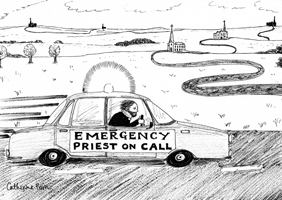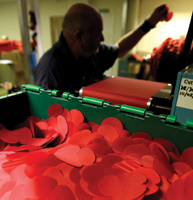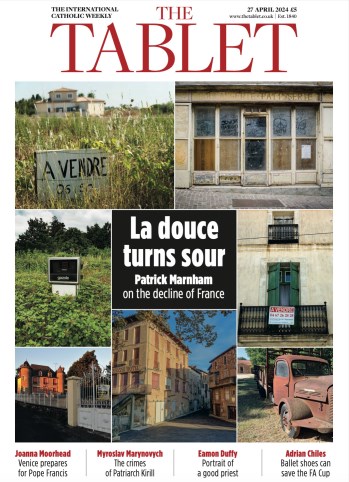The meaning of the poppy has been as divisive as it has been comforting. Its origins as the symbol of remembrance lie in a poem by a military doctor whose feelings about war were complex
KNOWN TO botanists as Papaver rhoeas, it also goes by several other names: field poppy, red weed, corn rose and, since the First World War, the Flanders or remembrance poppy.
It is said that its seeds spring to life when the soil in which it has rested is disturbed. It is often the first wild flower to appear after a battle. When conditions are right, the flowers grow in such profusion that they appear to turn the land blood red.
In May 1915 a Canadian military doctor, John McCrae, buried a friend who had been killed in one of the countless hellish bombardments of the war. The shattered remains of the young man, placed in sandbags and shaped to resemble a human body, were wrapped in an army blanket, and lowered into a grave. In the absence of an army chaplain, McCrae himself recited the church burial service as best as he could from memory.
Afterwards, McCrae sat on the steps of an ambulance and, surrounded by the wild poppies growing in the churned-up ground, scribbled a poem:
In Flanders fields the poppies blow
Between the crosses, row on row,
That mark our place; and in the sky
The larks, still bravely singing, fly
Scarce heard amid the guns below.
We are the Dead. Short days ago
We lived, felt dawn, saw sunset glow,
Loved, and were loved, and now we lie?
In Flanders fields.
Colleagues urged McCrae to have the poem published, and a few months later it was. Within days, copies of it were being passed around the trenches. From those few lines the poppy evolved into one of the most potent symbols of the war. The red flower became a link between the mystery of death, which has disturbed and fascinated mankind since time immemorial, and the battlefield slaughter of the new industrial age.
It was a many-faceted symbol. The Flanders Field poppy is blood red. It grows as a sign of new life where everything else has been destroyed. It demonstrates the power of the natural world to survive and revive. In Christian terms, and 100 years ago when the language of Christianity was more widely understood than today, the poppy told of the hope of resurrection.
In 1918, far away from the battlefields of Europe, Moina Belle Michael from Georgia discovered McCrae’s poem in a copy of the American Ladies’ Home Journal. She described later her first encounter with the words as being like a spiritual experience. A determined woman, she was so struck by the poem’s power and message that she lobbied the American Legion to adopt the poppy as the United States national emblem of remembrance. By September 1920, the newly founded veterans’ organisation had endorsed the idea at its convention.
Attending the same convention was Mme Anna Guérin, who quite independently had been promoting the sale of poppies made by widows and children of the American and French Children’s League. Inspired too by McCrae’s poem, she believed the poppy could become the international emblem “of justice, humanity and remembrance”. It was Mme Guérin who gave the idea to the newly founded British Legion, when in August 1921 she went to the legion’s offices to sell her poppies.
In Britain, the idea of buying and wearing a remembrance poppy quickly found favour. It was a way of coming to terms with personal grief and of making a public declaration for peace; that the 1914-18 conflict would truly be the war to end all wars.
Yet over the next 90 years the symbol of the poppy was to become as divisive as it was comforting. In the north of the post-First World War and newly divided Ireland, Catholics often saw it as a badge of Unionism. But more widely, the poppy came to represent conflicting ideals much the same as it had in the mind of John McCrae. He had written his poem in response to a personal and growing inner conflict between his instincts as a patriot and soldier, and his compassion as a doctor.
So what does the poppy stand for today? Is it a straightforward symbol of respect and gratitude to those who have died for their country; a declaration of patriotism; a show of support for the armed forces? In the words of the Royal British Legion slogan, a poppy is to be worn with pride. No, say others, it is to be worn with shame that humankind still resorts to wars. The annual sale of poppies triggers a regular and increasingly acrimonious debate. Last year a newsreader received sexist and racist abuse after she decided not to wear a poppy on air. Channel 4 presenter Jon Snow coined the term “Poppy Fascism” to describe the intolerance of those who claim it is the duty of all public figures to wear the flower of remembrance.
There is wide disquiet that the poppy has become a commodity, described in marketing circles as Britain’s “best-known charity brand”. The poppy endorsement has been used to sell a range of products from Hovis bread to Waitrose recipe books, and to boost the careers of celebrities. Poppy brooches and bracelets are available to buy. Golden bath oil with poppy seed, ladies poppy watches and even a poppy golf-umbrella can be bought online.
The justification given for the poppy appeal associating itself with the public relations and advertising industries, and celebrity culture, is that it is the best way to reach the younger generation. To them, every commodity of life is branded and marketed. From the wild flower of Flanders to a successful marketing and commercial brand, the remembrance poppy has travelled a long way. What would John McCrae make of it all? Would he grieve over the poppy’s perceived association with support for the military? Might he feel uneasy about events like the Festival of Remembrance; the military spectacular that culminates in red petals floating down from the roof of London’s Royal Albert Hall? They are a far cry from the reality of the slaughter he witnessed.
McCrae was not a pacifist, as the final verse of his poem makes clear:
Take up our quarrel with the foe:
To you from failing hands we throw
The torch; be yours to hold it high.
If ye break faith with us who die
We shall not sleep, though poppies grow
In Flanders fields.
His exhortation was to a victory that would give posthumous purpose to the lives of those who had been killed. He was writing just days after the sinking of the passenger liner, RMS Lusitania, torpedoed by a German U-boat off the Irish coast with the loss of 1,200 lives – news which might have given him a temporary boost of determination despite his growing disillusionment with the war.
Over the next three years, however, the disillusionment grew, and one of his colleagues noted early in 1918: “John did not seem at all like the ‘In Flanders Field’ person of former days, but was silent, asthmatic and moody.”
Following the third Battle of Ypres in 1917, McCrae wrote another poem, “The Anxious Dead”. No longer were the ghosts of the battlefield issuing confident demands. “These fought their fight in time of bitter fear, and died not knowing how the day had gone,” he wrote now. The poem appears to say that the dead will only rest in peace once the guns are silenced. Who wins or who loses the battle is now less important. Peace is the goal.
“After a war experience of four years,” wrote Canon Frederick George Scott, McCrae’s colleague as a Canadian army chaplain, “one is almost ashamed to look back upon those early days … The hideous thing was then only in its infancy … Yet with a deepening knowledge of the instruments of death has come, I trust, a more revolting sense of the horrors and futility of war. The romance and the chivalry of the profession of arms has gone forever.”
Scott wrote his own response to McCrae’s poem under the title “Rememberance” (sic). It starts as an echo of his friend’s verse, reflecting on the war cemeteries, “now roses of rememberance grow, where once the poppies used to blow”, but comes to a very different conclusion:
The price for peace our heroes gave,
Pray God from future wars may save,
Lest other heroes find a grave
Like Flanders Fields.
The torch they threw from stricken hand,
God grant shall light a better land,
And all the world united stand
By Flanders Fields.
If McCrae had written his poem with the same hindsight, Scott’s version is what he might well have composed.
So why, if the mood and morale of the fighting troops changed over the course of the war, did the poem retain its popularity? Why, after the war, did it still resonate with the public?
One has to consider the national mood in Britain after the armistice had been signed. It contained elements of relief, guilt, trauma and regret. The 1914 propaganda, that the war was to be a short-lived military adventure, over by Christmas, had long been exposed as either lies or delusion.
But in 1918, few who had been through the war wanted to believe it had all been a shocking waste of time, money and life. The spirit of 1915 was the compromise instinctively reached. That spirit captured the moment when the initial enthusiasm for war was tipping towards the later unrecoverable feelings of desolation and purposelessness. That was the mood captured in McCrae’s poem.
The poppy is an appropriate symbol of remembrance because it captures the essential ambivalence of remembrance: how do we honour the sacrifices of those killed in war, while abhorring war itself. It has also become a leading charity brand; a symbol of patriotism; a mark of respect to the fallen; an expression of support for “our heroes” in Iraq or Afghanistan; a mask behind which politicians hide; a focus of sentimentality at the Festival of Remembrance. The poppy means so many things, as it did to John McCrae writing in his notepad in a field station near Ypres almost 100 years ago – wracked with his own inner conflicts as patriot, soldier and healer.
Ted Harrison is a writer and artist. He is the author of Remembrance Today: poppies, grief and heroism, published by Reaktion Books.





 Loading ...
Loading ...
What do you think?
You can post as a subscriber user...
User Comments (1)
What is quite misunderstood is what Miss Michael was shown in that Thanksgiving issue of the Ladies' Home Journal. The editors did not for some obscure reason
just print this Canadian's 1915 battlefield poem. It was
use, mis-titled, with error about the author in a full page, full colour patriotic advertisement placed by Bauer & Black surgical supplies. She notes it was the illustration that inspired her - a garish painting by Philip Lyford for Doughboys rising from the flames heavenward against a sword cross, suitably bandaged, she felt was calling out to her personally to use the unrelated poem's floral imagery to adorn herself. How this dreadful ad was viewed by LHJ's Canadian subscribers is, sadly, not on record.